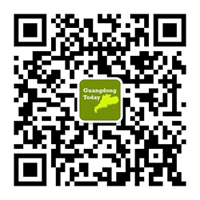According to the 'World report on vision' released by the World Health Organization on October 8th, 2019, "at least 2.2 billion people around the world have some kind of visual impairment."
However, art in galleries is traditionally curated for a sighted audience, and so in a landmark new effort to curate an exhibition of contemporary art catering to both a sighted and visually impaired audience, the Guangdong Museum of Art launched a new exhibition entitled ‘Eyes and Beyond: Art Sharing Project for the Visually Impaired’ on April 30th.

The exhibition: 'Your Eyes', 'My Eyes', and 'New Eyes'.
'Your Eyes' explores the artistic transformation of people with impaired vision's experience of the world.
Taking visually impaired people’s perspective as the jumping off point, 'My Eyes' is an artistic experiment that manifests the ranges of perception and behaviour of people with a visual impairment.
'New Eyes' probes into the boundary of artistic imagination to highlight that which is normally unseen, regardless of whether the viewer themselves has a visual impairment.
Pieces including sculpture, photography, video and installation works by ten artists are exhibited in poor light, with introductions in Braille, Chinese characters and audio. Visitors are encouraged to engage their other senses, be they touch or smell and to close their eyes and listen.
The exhibition is also accompanied by an educational program facilitated by museum staff.
In the reading area, you can browse cards in Braille, read colour books about visually impairment, or watch a video to learn more about reading materials for those with sight loss.
In the interactive area, you can try on a pair of special glasses to view the exhibition to experience what a visual impairment can feel like, or test your sense of touch, by trying to draw an object from touch alone. The object was sculpted in clay by a visually impaired child, and the museum staff will happily tell you whether you got it right if you show them your sketch.
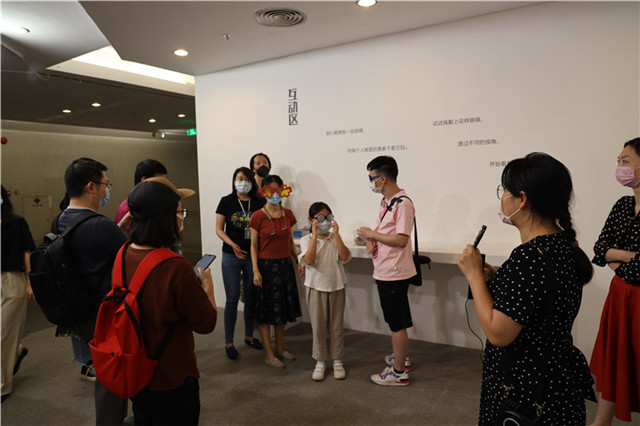
Visitors try on special glasses at the interactive area.
According to curator Zhang Fen, the exhibition was designed for both a visually impaired and sighted audience: "What we are striving for is that in the exhibition, spectators with no visual impairment can gain insight into the perception of a visually impaired person, while presenting an exhibition that can be fully enjoyed by a visually impaired visitor."
"We want to use the ideal world of art to create these rare and temporary moments, where we can transcend physical differences, and understand and embrace each other through the possibilities of art," the curator pointed out, "In the hope of indicating the existence of differences through art, the exhibition aims to inspire acceptance, understanding and tolerance, rather than eliminating those differences."
Planned and organized by the Guangdong Museum of Art, the exhibition 'Eyes and Beyond: Art Sharing Project for the Visually Impaired' is one of the exhibitions in the support program for young curators in Chinese art museums in 2019 selected by the Ministry of Culture and Tourism.
A Chong: I am very happy to be able to 'see' so many art works
On the opening day, local young man A Chong, who is partially sighted and a member of the Guangzhou Library Readers Committee, visited the exhibition accompanied by Feng Shifeng, a volunteer from a local team dedicated to promoting barrier free access and helping the visually impaired with audio description.
Feng showed A Chong around the exhibition halls, read the foreword and the curator's message on the display boards for him, described the artworks, guided him to touch the pieces or simply let him listen to the audio description. Later Feng introduced A Chong to both the curator and artists, so that he could share his impression of the exhibition.
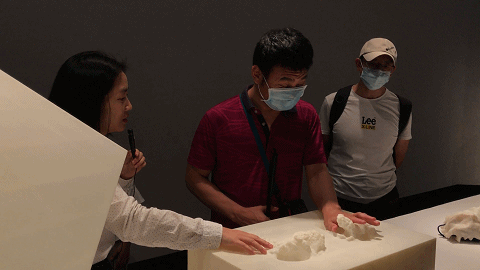
A Chong (M) feels the art piece 'Shake Hands' with his hand.
A Chong said he was both excited and touched by the experience, "Due to my sight loss, I have struggled a lot to get to know my surroundings, and there is still much I don’t know. With Feng and others describing the exhibits for me, however, I have enjoyed this exhibition without this kind of difficulty. I am very happy that I could 'see' so many artworks today."
"The pieces are very interesting," A Chong told the reporter, "The video depicting a camera tied to a cane tapping around the environment vividly portray how some visually impaired people explore the world with the cane. Another installation, 'Shake Hands' forces us to communicate solely through touch, a very universal human experience."
A Chong has suggested that the organizers add audio descriptions of the image and scenes in all the exhibition halls.
Feng responded that he and his team will work with the museum to produce audio description of visual pieces for visually impaired visitors.
Introduction to key pieces
Your Eyes
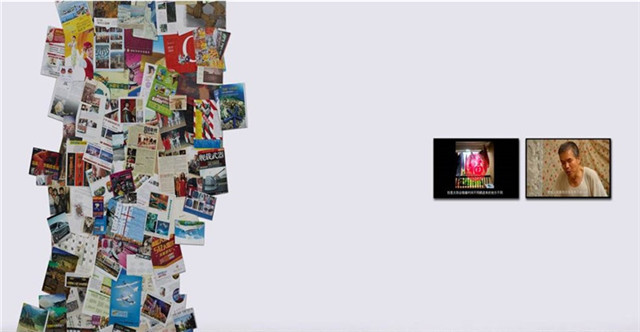
Fan Bo 'World3' 2016
Assorted mediums (print materials+braille+video)
Mainly private records collected from visually impaired families, such as menus, lyrics, addresses, phone numbers and poems in braille on ready-made print materials including leaflets, magazines and postcards. The information in braille and the content on the print materials represent the collision and convergence of two totally different worlds.
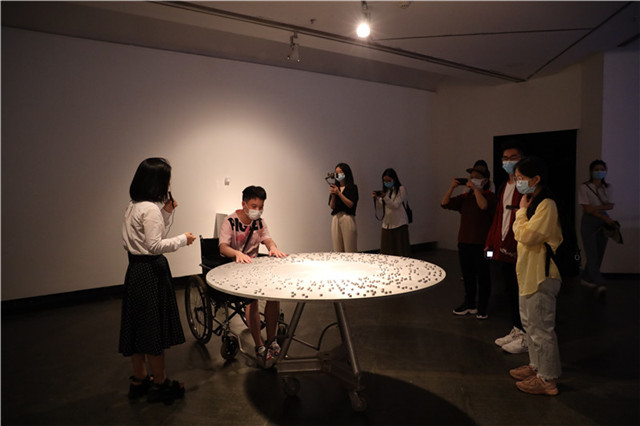
Li Xiuqin 'Zi Du' 2013
Assorted mediums (metal braille installation)
Sculptor Li Xiuqin almost lost her vision, and she has been devoted to creating artworks for the visually impaired ever since. Her installation is a rotating table with metal braille inlaid and a wheelchair allowing visitors can sit and feel the world, space and nature depicted by the metal braille.
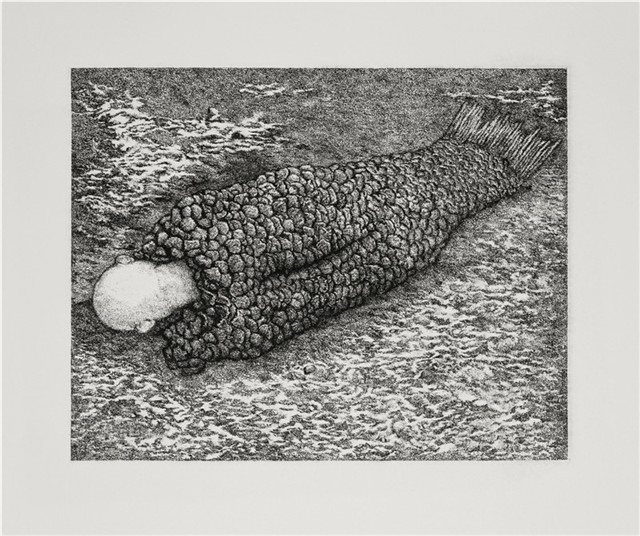
Wang Weirong 'A love letter that we will never be able to send out' 2020
Assorted mediums (woodblock painting+copperplate+script)
Woodblock painting artist Wang Weirong transliterated a love letter into braille, and then created a copperplate etching inspired by the letter. The title of the work is printed in white on a white wall. As a whole the artwork presents some kind of mystery which the artist hopes will spark the same romantic feelings in both the able-bodied and the visually impaired.
My Eyes
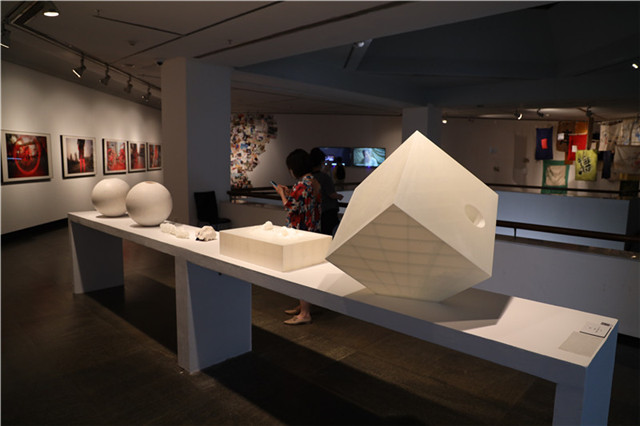
Sui Jianguo 'Shake Hands' 2020
Interactive sculpture group (3D printed with photosensitive resin)
Artist Sui Jianguo blindfolded himself and sculpted fingers and palms, then hid them in a blind box for the audience to feel. Each hand placed on the sculpture is like shaking hands with the artist, and this experience differs in no way regardless of visual impairment.
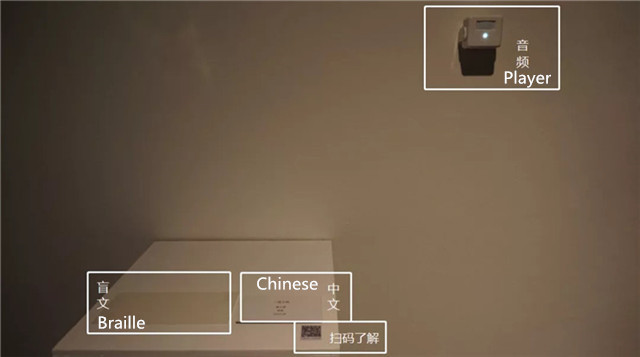
Hui Ganyuan 'Clear with hearing' 2020
Knowing that people with visual impairment are used to speeding up their screen readers to get information efficiently, Hui recorded audio guides for all the artworks at a higher speed than usual and installed the players on the wall with an infrared trigger. Once a visitor comes close to the artwork, it will automatically play audio instructions which is geared towards people with sight loss and may sound uncomfortable for other visitors. This tension creates another temporary 'balance' in art appreciation for both groups of people.
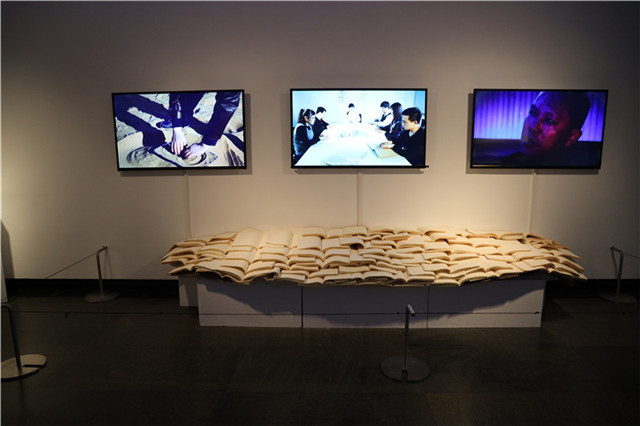
Huang Wenya 'Seeing is not Believing' 2015-2017
Video length: 13'04'' 8'38'' 14'23''
Huang has been curious about the perception of the visually impaired since he was young. The videos are about people with sight impairment learning how to navigate their environment in the desert, on a flyover, in KTV and other environments. In front of the video is a pile of Braille books which are also the scripts of the videos.
New Eyes

Mo Yi 'Red flashlight: I am a dog' 2013
Photography 80.5×125cm×6 pieces Collected by the Guangdong Museum of Art
Conceptual photography artist Mo Yi depicted the city from 'a dog's point of view' through holding the camera upside down and many more simple techniques to create sloshing, blurry and alienated images surpass the experience of both sighted and visually impaired visitors, presenting the world beheld by another 'eye'.
Qin Siyuan 'Sound and image of canes' 2020
Qin Siyuan interviewed blind people in Guangzhou, collecting their answers for 'favourite sound', which he later interpreted in Morse code. The 'dots' and 'dashes' were recorded by taping a camera and microphone to the bottom of a cane, giving the audience a chance to observe the world from a brand new perspective.
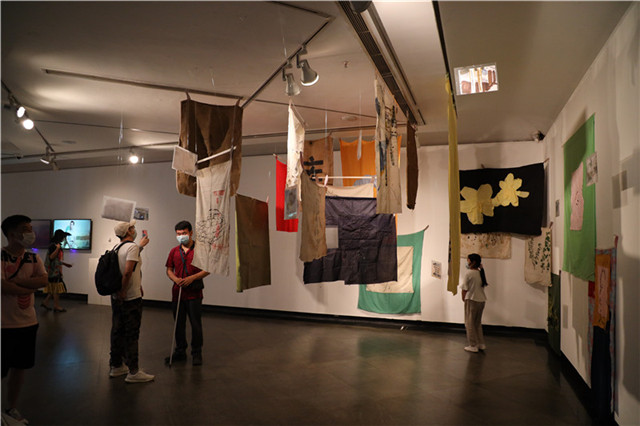
Lu Shan 'Grain depot' 2020
Assorted mediums (cloth embroidery+painting)
Artist Lu Shan collected aged grain bags and created artworks on them: embroidery, rubbing, collage and acrylic paint. The audience can walk through these paintings touching, seeing and even tasting them, provoking a sense of nostalgia.
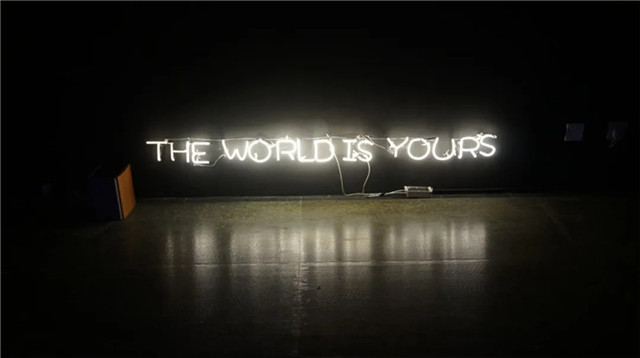
Chen Wenhua ‘The world is yours’ 2020
Audio + video (14 original animation short films)
These animations aim to enable both the able-bodied and the visually impaired to confront reality and their anxieties. Around 500 unique voices tell the visitor "The world is yours" in different languages and dialects.
Visitor information
● Period: Until May 24th, 2020
● Venue: Halls No. 10 & 11, 3rd Floor, Guangdong Museum of Art
● Admission: Free
● Opening hours: 9:00-17:00, with no entry to be allowed after 17:00. Closed on Mondays (apart from public holidays).
● Inquiry hotline: 020-87351468
● Daily maximum capacity: 400 visitors, with a visitor flow of no more than 15 people in each exhibition hall at any one time.
● Reopened areas: The exhibition halls on the first floor, the sculpture garden in the inner courtyard, and the South Square
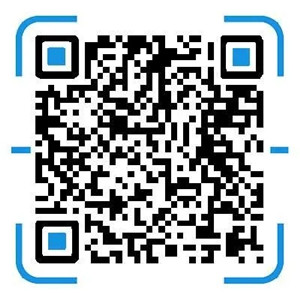
Long-press the QR code to make a reservation.
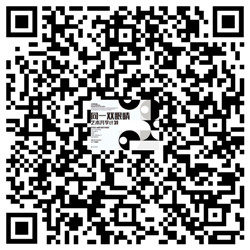
Long-press the QR code to view the exhibition online.
1. Visitors are required to make a real-name reservation for tickets online in advance and enter venues during the specific reserved time period with valid documentation. Only individual visitors are accepted now.
2. Visitors are also required to provide their 'Yuekang code' (粤康码) or 'Suikang code' (穗康码), and have their temperature checked upon entering the venue. People with a temperature exceeding 37.3℃ or showing symptoms such as a cough or breathing difficulties will be refused entry.
3. Wear a mask and try to keep at least 1.5 meters from others during the whole visit. Avoid gatherings and face-to-face communication. Pay attention to personal hygiene and disinfection.
Authors: Monica Liu & Zoey Huang (intern)
Editor: Simon Haywood
Photos: Guangdong Museum of Art
